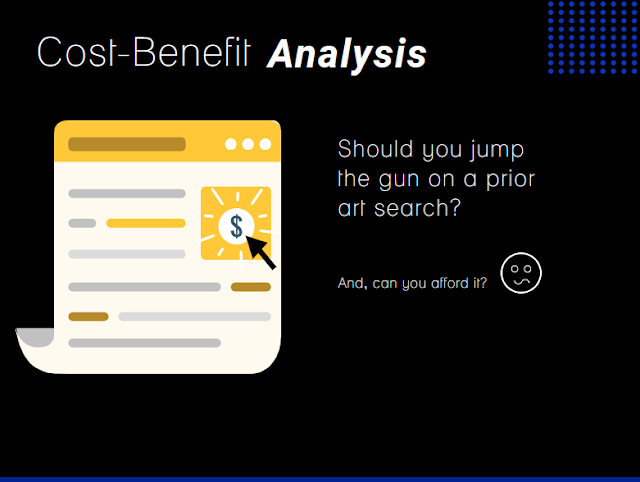Patenting is a very costly process, particularly in the US. And, if your invention has a lot of potential, you need to patent it all across the globe so that some other brand does not capitalize by selling a knock off version of your invention.
However patenting an invention is no longer a very lucrative procedure for small businesses. This is because, a large chunk of applications get rejected. Plus, those inventions which are granted patent protection, face a constant threat of being challenged in the courts by the competitors.
As such, businesses are trying to keep their inventions hidden as trade secrets in this day and age. However not all inventions can be kept as trade secrets. Plus trade secrets, if leaked, can result in a disaster for the business concerned.
In order to make sure that the process does not result in a humongous waste of time and money, we asked the experts –
“What are the due diligence essentials that an inventor has to do before submitting his/her invention for a patent application, considering the huge costs of patenting and the chances of it getting later revoked.”
If you do not know, what due diligence is, this video will come in handy-
That, out of the way, here’s what the experts had to say!
Experts’ Opinions on Conducting Essential Due Diligences Before Applying for a Patent

#1. Alex Montagu, author of the book “Intellectual Property Money and Power in a New Era” and the founding partner of Montagu Law, a law firm which specializes in IPs, trademarks, copyrights and patents:
“In order for a patent application to be granted the invention has to be “novel” and not an obvious extension of a prior invention. The requirements of novelty and non-obviousness inform the due diligence required prior to filing a patent application. The due diligence is called “prior art” search. It is usually undertaken by patent counsel. It is a search to determine [whether] any prior inventions or patents may be obstacles to the grant of the sought-after patent.
The costs of obtaining a utility patent in the US are approximately 10k to 20k. These costs are minimal compared to the costs of enforcing patent rights. It is not unusual for a patent infringement litigation to exceed 1 million dollars in counsel fees and often it is far more than that.”
– Alex Montagu
Considering the stress on prior art search by Alex Montagu, the next expert however provides an opinion to the contrary. This is completely normal as conducting due diligence before applying for a patent is a strategic affair and therefore, there may be varied opinions on the subject.
It is therefore important that you read their opinions and thereupon make an informed choice of which path you wish to follow.
#2. Dylan O. Adams, a Seattle-based patent attorney who focuses on startups and the author of the book Patents Demystified: An Insider’s Guide to Protecting Ideas and Inventions which is an official patent guide of the American Bar Association:
“The two main points of due diligence that an inventor should consider doing before filing a patent application are:
- making sure the invention is the type of thing that can be patented and
- doing a patent or prior art search and determining whether the patent application might be rejected during examination for lacking novelty or being obvious in view of known technology.
The first point of due-diligence is fairly simple.
For example, if the invention is a work of art, screenplay or book, it cannot be protected with a patent, but could be protected with a copyright.
Similarly, if the invention is a product name, logo or slogan, then this could be protected by a trademark, but not a patent.
In contrast, patents specifically cover utilitarian inventions, which can include physical objects and methods of operation, use or manufacturing. Most inventors can determine this themselves or via a typically free initial consultation with a patent attorney.

Regarding patent or prior art searching and patentability analysis, it may intuitively seem like this would be a natural and standard part of the due diligence process before filing a patent application, but surprisingly, such a search and analysis is rarely done and rarely makes sense from a cost-benefit standpoint. For example, such a search and analysis is unfortunately not typically easy for inventors to effectively do themselves.
Having a patent attorney or search firm do the work can be fairly costly (e.g., $1,000 – $4,000 or more) and is unlikely to provide any truly actionable information in most cases. There is always going to be relevant prior art out there and the ultimate conclusion is typically “this may be patentable, but we don’t know for sure.” Honestly, patent and prior art searching is often a way that some patent attorneys up-sell their clients unnecessary services.
Also, by default, patent applications are held in secret for at least 18 months from their earliest priority date and potentially up until they issue as a patent, which can be many years, so there is a large world of potentially relevant prior art that is completely hidden and undiscoverable, but that could still be used against a patent application in examination.

Accordingly, the most cost-effective strategy for most technology is to file a patent application and let the patent examiner frame the issues and not try to speculate on what examiners might consider to be relevant or not.
Also, surprisingly, the question of whether a patent application will ultimately issue is actually not all that important in many cases. Given how long the patent process takes (several years) many of my clients get substantial product traction, major investments or even sell their company based on pending patent applications alone. What’s ultimately important at early stages (and surprisingly) is perceived ownership and patent pending status.
Also, it’s important to note that patentability is not a binary thing (i.e., just patentable vs. not-patentable) and it’s actually more of a spectrum of possible protection.
Honestly, getting a patent issued is typically not the problem, but instead it’s getting a patent allowed that broadly covers the invention and hopefully a wide variety of variations so competitors can’t easily design around the patent.
That being said, there are some cases where a patent or prior art search would be highly recommended, such as in the case of simple consumer products where novelty or obviousness may hinge on one single element.”
– Dylan O. Adams
#3. Judith Szepesi, a patent attorney with 25 years of experience and partner of the law firm Nicholson De Vos Webster & Elliott LLP:
“The essential due diligence before deciding to file a patent application on your brilliant idea requires two steps.

First, you should have a good feel for what other products/services are out there that you are competing with.
Having a patentable idea is well and good, but is it worth the investment of your time and effort?
Do you think that it will make back your investment in time and money, and opportunity cost?
It is generally more effective to do a search online, rather than in the Patent Office, because patents are often written in a way that makes them hard to understand.

Second, once you have done the initial search, and decided to move forward, I recommend working with a patent attorney to do a quick a prior art patent search. An attorney should be able to do a quick search and give you a feel for what’s out there in patents.
I’m not a fan of “true clearance searches” because with the 18 month plus publication delay, there is no way to find every potentially conflicting patent publication. Instead, get a feel for the patent landscape.
Are there hundreds of patents on various small solutions very similar to yours?
That means you are likely to get a narrow patent. Has no one recognized the existence of this problem you are solving? You have the potential to get a broad scope solution patent.
One other diligence step is finding a good patent attorney or agent to work with. You should talk to at least two or three, and discuss in broad sweeps your invention. No need to give them the details at this stage.
They should understand the technology, and ask smart questions. You should trust them to get what you’ve invented without your having to educate them about the technology space. They should make you think with their questions (especially around the applicability of inventions – engineers often focus on the specific problem they are solving, and don’t think about other spaces that their solution could apply to.)
My final piece of advice for new inventors is to be rational about what a patent is, and is not. A patent, once granted, is the right to exclude others from making, using, or selling your patented product, service, or feature. It does not mean that no one can have a competing product that implements it differently, nor does it mean that you can actually make the product without infringing anyone else’s patents.
A patent does not mean that you can successfully sell your patented invention. That is a different skill set. Patents and patent applications are useful to provide a protected advantage, for marketing, and defensively. They are not a magic wand.”
– Judith Szepesi
#4. Miranda Yan, founder of VinPit, a tech company dedicated to software development:
“Due diligence in the [case of] Patent itself could consist of different things for different circumstances.

For example, due diligence could be “offensive” when it is exercised to enquire whether a third party has infringed your business’s patent right or ” defensive” when it’s carried out to check if any part of your product or service would be subjected to infringement claims of another business or individual.
When we talk about due diligence to be observed before filing for a parent of an invention, the inventor needs to watch the following essentials to prevent revocation of their patent application:
- Check whether the patent application covers the technology in its entirety.
- Research whether the filing of the patent violates anyone else’s patent right. I.e., to enquire about the existence of prior art. A previous art search is usually conducted to ensure non-violation of this aspect.
- Mention who will hold the “inventorship” and get the “ownership” of the patented invention. These two terms aren’t to be confused.
- Filing of a patent application as early as possible. This is to be done to ensure that inventor’s rights are not wavered. Under US patent laws, an inventor must file the patent application before completing it one year after the invention was disclosed or offered for sale.
- Check whether there are any pending patent requests existing that have a likelihood with their invention. The inventor should also check that their invention is patentable and there is no blocking patent.
These are the significant essentials, but there are still many areas that need to be addressed before applying for a patent.”
– Miranda Yan
#5. William Cannon, CEO of Signaturely, a digital signature providing business:
“Whether you go for Defensive or Offensive diligence, always have an expert IP counselor by your side during the due diligence process.

While considering the patents of all other entities, always be keen to check the patent rights of Non-Practicing Entities (NPE).
Understand your invention, and always run a thorough check on all types of kinds patent-infringement that can block the way for your invention.
Never proceed ahead in due diligence before patenting your invention without the help of an expert patent attorney.”
– William Cannon
#6. Adam Philipp, a US patent attorney with over 25 years of experience in Intellectual Property matters and founder of the IP law firm, AEON Law:

“There are three requirements for every U.S. utility patent application:
- Novelty (it must be new);
- Utility ( the invention must accomplish something of value); and
- Non-obviousness (would a person of ordinary skill in the field come up with the same inventive solution if they were presented with the same problem.
Due diligence before filing is when an invention is reviewed to see if it meets all three of these requirements (novelty, utility, and non-obviousness).
However, there is an important reason not to do too much due diligence. That reason relates to rule 56 at the U.S. Patent and Trademark Office (37 CFR 1.56).
Rule 56 requires inventors to “disclose to the [USPTO] all information known to that individual to be material to patentability”. Doing excessive due diligence may unnecessarily increase the inventor’s burden of disclosing every potentially relevant reference found during their due diligence.
Savvy inventory will often work with a skilled patent attorney to create targeted queries with intentionally limited results to find only the closest possible reference for their dues diligence. Some inventors may even take Rule 56 so seriously that they will forego any due diligence ahead of time and rely only on the USPTO examiner’s search after filing a patent application.”
– Adam Philipp
For any queries or help with your startup, feel free to book a free consultation with us. You may also check out our list of services if you need any help with your business efforts.
Read Next:
- How You Can Protect Business Data or Inventions as Trade Secrets in the US
- Legalities You Must Know Before Starting a Company in the US
- Choosing your Business Legal Structure in the US: An In-Depth Guide
That’s all. Let me know what you think in the comments.
If you enjoyed this article or if it helped you in any way, do give it a share!




















